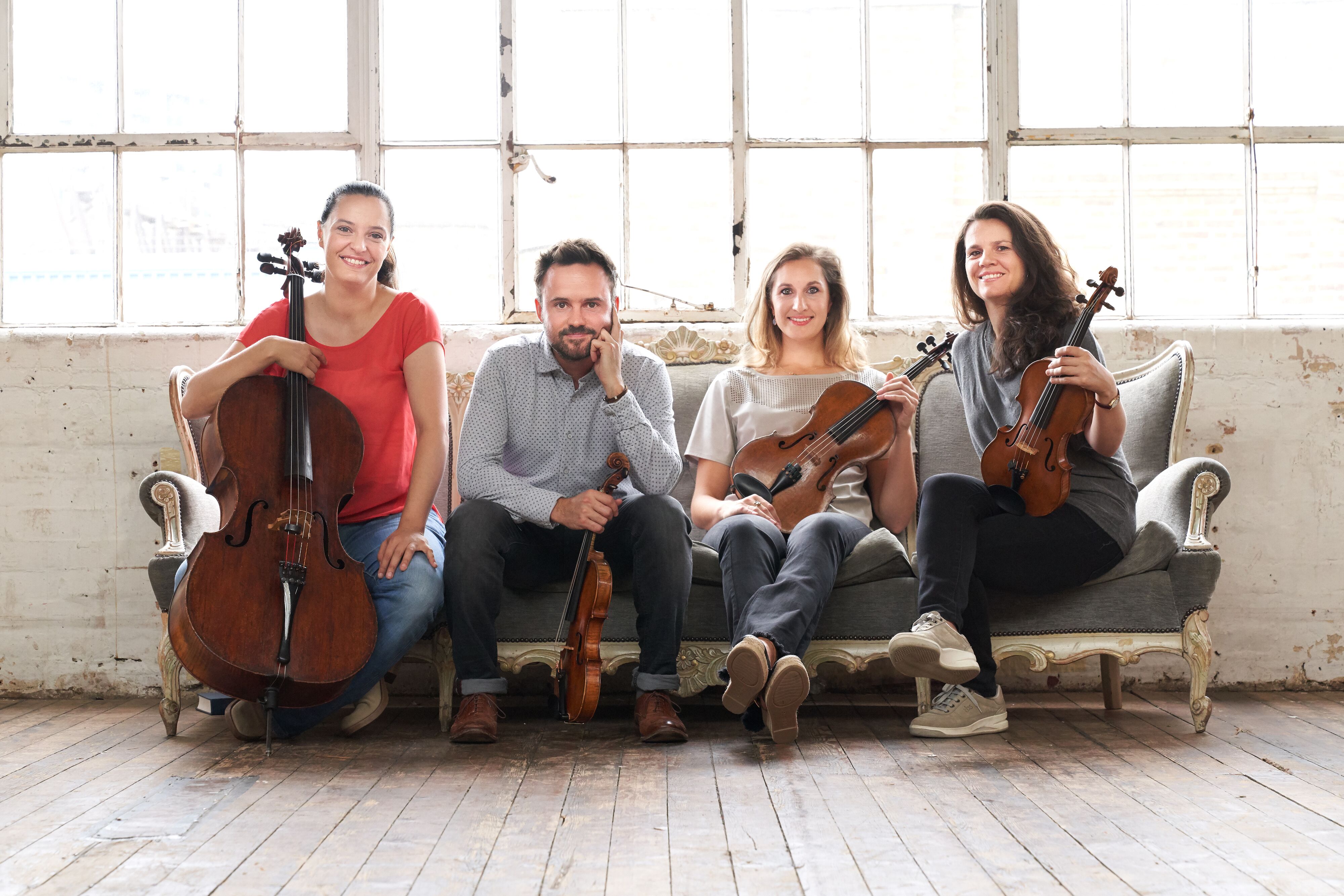Blog Post
GUEST BLOG: Insightful and immaculate playing from the Elias Quartet at Wigmore Hall
Article originally posted to seenandheard-international.com/
Claire Seymour May 1, 2022 "Insightful and immaculate playing from the Elias Quartet at Wigmore Hall"
Stravinsky, Beethoven, Shostakovich: Elias String Quartet (Sara Bitlloch and Donald Grant [violins], Simone van der Giessen [viola], Marie Bitlloch [cello]), Steven Osborne (piano). Wigmore Hall, London, 3.1.2023. (CS)
Stravinsky – Three Pieces for String Quartet
Beethoven – String Quartet No.10 in E flat Op.74, ‘Harp’
Shostakovich – Piano Quintet in G minor Op.57
It’s been a quite a while since I heard the Elias Quartet perform live, though I did enjoy their disc of Schumann Quartets on the Alpha label, which was released in 2018, the same year that they presented a highly acclaimed Schumann series at Wigmore Hall. This recital programme at the Hall caught my interest as it offered the opportunity to hear Stravinsky’s rarely performed Three Pieces for String Quartet and also Shostakovich’s Piano Quintet, in which the Elias were joined by pianist Steven Osborne, with the two twentieth-century Russian works framing Beethoven’s ‘Harp’ Quartet. Looking back at my past reviews of the ensemble’s performances, I seem to have drawn certain qualities repeatedly to the fore – the Quartet’s scrupulous attention to detail and perfectly blended and balanced collective sound, for example. This performance was similarly intense and immaculate, the unwavering technical control serving music-making of great vitality.
Inspired by what she termed Stravinsky’s three ‘grotesques’ for string quartet, the poet Amy Lowell imagined the first movement as a peasant dance with ‘wooden shoes beating the round … And a shaking and cracking of dancing bones’. The Elias’s rendition was both chiseled and highly kinesthetic, as the multiple ostinato figures piled up. Stravinsky’s synthesis of the techniques he had employed in The Rite results in a paradoxical union of stasis and progression: the music is mechanistic, futurist even, but the Elias found expressiveness in the rhythmic manipulations and metrical patterns, using color, texture and dynamics to create a vivid miniature tableau of, as Lowell imagines, ‘Red, yellow, blue,/ Colours and flesh weaving together,/ In and out, with the dance’. The spare, paleness of the second movement cleansed the air, the small gestures withdrawn but preciously sculpted. In the final movement there was a sense of wistfulness at times as Stravinsky draws on Russian folk motifs. The opening had a dirge-like sobriety, but the glassiness of the string sound gradually softened and warmed, and there was tender pathos in the sul tasto delicacy of the close.
Composed in 1808, Beethoven’s Tenth String Quartet, nicknamed ‘the Harp’ on account of its cascading pizzicato passages in the first movement, shares its Eb major key with the Emperor Concerto which the composer was working on simultaneously and completed the following year. And, if it lacks the latter work’s grandeur and majesty, the quartet is no less ambitious and innovative with regard to Beethoven’s envisioning of the string quartet genre as a medium for profound musical utterance and his equalising of the four voices with subsequent enlargement of the canvas of textures and colours available.
With their characteristic concentration and discipline, the Elias created a penetrating reading but also one that was immensely engaging – even the whispered harmonies that open the Poco adagio immediately caught one’s attention; there was not a motif or phrase that was not carefully considered and meaningfully interpreted. The punctuation points were thoughtfully marked, dynamics sharply delineated, and with the arrival of the Allegro, came a relaxing flood of warm, a brightening of the ensemble sound, a real sense of freshness and joy. Textures were crystal clear, but the rapid scales that dart back and forth between the voices formed a full, well-rounded whole. And, the players enjoyed their pizzicato volleying, their voices evenly matched but differentiated in tone – these were vivid conversations. Enormous energy was generated in the development section, seeming to anticipate the remarkable, almost bacchanalian, coda which again was characterized by clarity of motivic interplay.
The Adagio ma non troppo was ardent and lyrical, the four long-breathed lines richly filling the musical space with warm, full tone. Sara Bitlloch’s cantabile theme was refined but full of happiness; Marie Bitlloch’s cello provided eloquent, tasteful direction from below. The symphonic punch of the roaring Scherzo was impressive: racing, but taut, it was the weight of the sound rather than the speed that made a real impact, and when the Trio began, launched with vigor by the cello, it had a heroic, even defiant, quality. The pianissimo fragments at the close seemed to smile as they slipped segue into the concluding, good-tempered Allegretto con variazioni, in which each variation was thoughtfully characterized, and which, after a burst of fortissimo unison semiquavers, disappeared with a deliciously delicate cadential farewell. The French musicologist Joseph de Marliave described the Harp Quartet as ‘the key to the soul of Beethoven’. The Elias seemed to have found the answer.
Shostakovich’s Piano Quintet was first performed on the evening of November 23, 1940, at a dekada – a ten-day cultural event, common during the Stalinist years, during which many new works would be presented. According to the composer’s biographer, David Rabinovich, who was present at the premiere, it made quite a stir: ‘It came at the end of a concert after three new quartets by three leading Soviet composers had been played. The audience was growing tired. But when the Beethoven Quartet, so well-known to Moscow music-lovers, appeared on the stage with Shostakovich himself, and when the first strains of the Quintet resounded, all workaday, dearly-beloved and accustomed sensations disappeared without leaving a trace. Obviously something important was happening in the hall, something that was outside the scope of “current” musical events.’
Certainly, pianist Steven Osborne made one sit up and take note when he began the Prelude’s statuesque opening solo, which allied a granite-like presence with a driving sense of purpose. The entry of the strings created a striking texture, with the strings tightly packed and the cello at the top of the group, high up the fingerboard, with the piano then re-entering and reaching towards both ends of the keyboard. Osborne communicated intensely throughout the Quintet, his bass line providing subtle but persuasive direction in the light-as-air Fugue, though it was left to the strings to thoughtfully articulate the motivic dialogues of the Adagio which closes the second movement.
Even when the textures were sparse, or the gestures quiet, there was something ‘symphonic’ about the musical events. The Scherzo surged robustly, the satire tinged with a manic tint; the conversations of the Intermezzo – the first violin melody unwinding above eloquent cello pizzicato, the viola entry bringing warmth – were beautifully shaped, if colored with the composer’s familiar desolation, forming the expressive heart of the work; and the Finale flowed richly forward in lighter spirits but never entirely carefree.
-Claire Seymour, Seen and Heard International
Sounds like a concert experience for you? Grab tickets to the Elias String Quartet's performances at Gallagher Bluedorn March 21-24. With three concerts featuring different repertoire, in addition to complimentary wine and cheese, this experience is one you can't pass up.



